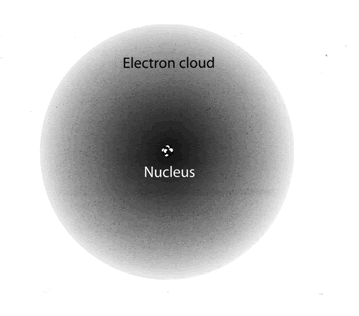Electron

Electrons are negatively charged particles that exist in a cloud around the nucleus of an atom. They are unimaginably small, so small that quantum mechanics is needed to explain their peculiar behaviour, as far as physics has been able to determine they are a fundamental particle. For the scope of this encyclopedia, it is best to imagine electrons as tiny particles that "orbit" the nucleus of an atom (other resources below for a more advanced interpretation). However, instead of the gravitational force that's responsible for moons orbiting planets, the electromagnetic forces causing the electrons to "orbit" the nuclei. For more on the physics of electrons please see hyperphysics.
Electrons and Electricity
Electricity is the flow of electrons through a conductor (usually in the form of a wire, this flow is called a current. In order for this flow to occur, electrons must break their atomic bond (electricity is the flow of electrons, not the flow of electrons and the nuclei they happen to be bonded to). Breaking the atomic bond between an electron and its nucleus requires an input of energy which causes the electron to overcome the electromagnetic force constraining it and thus flow freely. This needed energy can be harnessed from a number of different sources, a few examples are:
Conductive material
All forms of matter contain electrons, however, the electrons in certain materials are more loosely bound to their nuclei. These materials (known as conductors or metals) require very little energy to create a current, because loosely bound electrons require much less energy to overcome the electromagnetic force keeping them in place.
What generates electron flow?
Electric generators are devices that use the principle of electromagnetic induction - this is the process of moving a conductor through a magnetic field in order to create electron flow. Note: only a relative movement of the conductor and and magnetic field are needed, meaning the magnetic field could be moving and the conductor stationary. When the electrons in the conductor pass through a magnetic field (if the field is strong enough and the conductors relative velocity through the field is fast enough) then the bonds to their nuclei will be broken and a flow will be induced. In order to induce a high level of electron flow a great deal of energy is needed in order to create relative velocity between the conductor and magnets.
Chemical reactions inside of batteries also create an electromotive force causing electrons to flow in a circuit. Photons (light energy) can also cause electrons to flow when they strike a photovoltaic cell.
External resources
To learn more about how electrons form matter with protons and neutrons please see our page on atoms. For deeper physics on the electron please see hyperphysics. For more about how electrons are relevant to chemistry please see UC Davis's wiki. To just play around with different models of electrons around an atom, please see PhET's models of the hydrogen atom.
References
- ↑ "The electron cloud" internet: http://letstalkaboutscience.wordpress.com/2012/02/16/the-electron-cloud/

